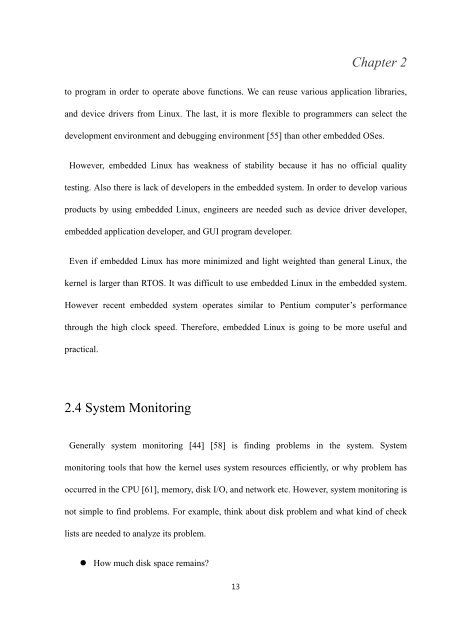Chapter 4 - DSpace at Waseda University
Chapter 4 - DSpace at Waseda University
Chapter 4 - DSpace at Waseda University
You also want an ePaper? Increase the reach of your titles
YUMPU automatically turns print PDFs into web optimized ePapers that Google loves.
13<br />
<strong>Chapter</strong> 2<br />
to program in order to oper<strong>at</strong>e above functions. We can reuse various applic<strong>at</strong>ion libraries,<br />
and device drivers from Linux. The last, it is more flexible to programmers can select the<br />
development environment and debugging environment [55] than other embedded OSes.<br />
However, embedded Linux has weakness of stability because it has no official quality<br />
testing. Also there is lack of developers in the embedded system. In order to develop various<br />
products by using embedded Linux, engineers are needed such as device driver developer,<br />
embedded applic<strong>at</strong>ion developer, and GUI program developer.<br />
Even if embedded Linux has more minimized and light weighted than general Linux, the<br />
kernel is larger than RTOS. It was difficult to use embedded Linux in the embedded system.<br />
However recent embedded system oper<strong>at</strong>es similar to Pentium computer’s performance<br />
through the high clock speed. Therefore, embedded Linux is going to be more useful and<br />
practical.<br />
2.4 System Monitoring<br />
Generally system monitoring [44] [58] is finding problems in the system. System<br />
monitoring tools th<strong>at</strong> how the kernel uses system resources efficiently, or why problem has<br />
occurred in the CPU [61], memory, disk I/O, and network etc. However, system monitoring is<br />
not simple to find problems. For example, think about disk problem and wh<strong>at</strong> kind of check<br />
lists are needed to analyze its problem.<br />
� How much disk space remains?

















